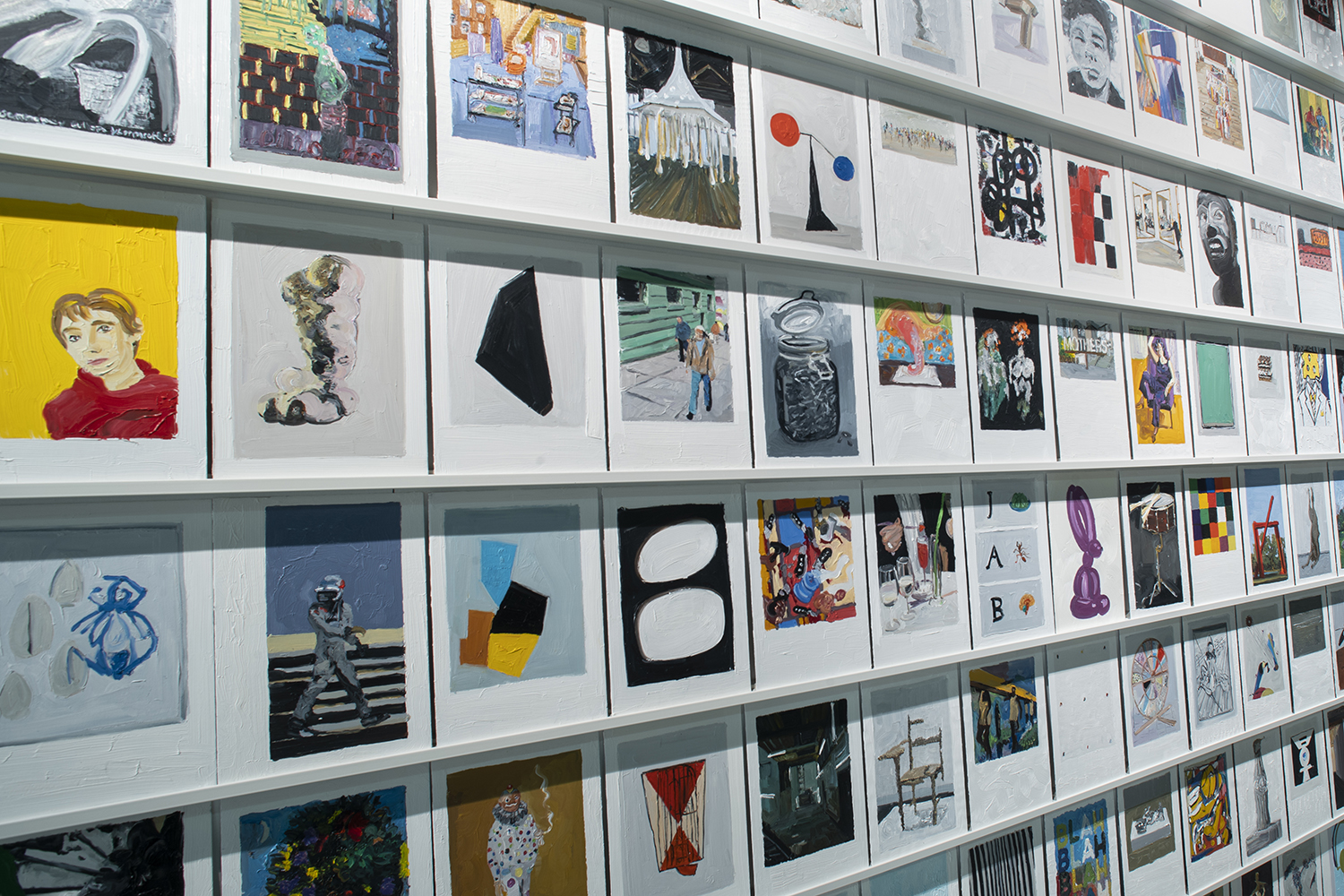
Philippe Cognée. Painting After
Colin Lemoine, curator of the exhibition ‘Philippe Cognée. La peinture d’après’ at the musée Bourdelle, analyzes the approach of an artist who always paints with others: proliferation and repainting, germination and finitude are considered by the author.
Painting is always painted after. After another, after others; after oils on canvases and temperas on wood; after polyptychs on gallery walls or history paintings along church aisles; after Cimabue, Rembrandt, Van Gogh or Cézanne; after crucifixions, self-portraits, wheat fields, or bathers; after Frenhofer and Elstir; after Lascaux and Pompeii; after aurochs in damp caves or Bacchic cults in parched tombs. Painting is always painted after painting. […]
The exhibition ‘Philippe Cognée. La peinture d’après’, centering on his major project Le Catalogue de Bâle (2003–2013), is the largest to have been devoted to the artist in Paris to date. […] Presented in the musée Bourdelle’s striking extension designed by the architect Christian de Portzamparc in 1992, the show’s three sections explore a process of re-painting [1], through which Philippe Cognée reappropriates works from the past and, like a modern-day Janus, looks to the yesterdays to seek out the tomorrows, a manner of recognizing the fate of any painting, which, while it always comes after, can still show again and anew, obstinately and freshly. In a word, inexhaustibly.
RE-PAINTING
In Picasso, Cézanne. In Cézanne, Manet. In Manet, Velázquez. In Velázquez, El Greco. Such nested influences and homages have traced a history of art made of quotations and allusions, of deliberate borrowings and unconscious slips. For his part, Cognée draws on iconic works, not so as to copy them slavishly, not to duplicate them in the academic style, or with a sterile virtuosity, but to disfigure them by means of a tried- and-tested technique: after executing an encaustic (hot wax) painting, the artist covers his composition with a plastic film, which he then melts with an iron, thereby creating a highly recognizable shaky effect and a burying of the painting material. […]
It is a political act, then, to interfere with the workings of the world, to counter that over-saturation.
For this is Philippe Cognée’s discovery: despite the denaturation inferred by his method, despite the alteration of the painted surface, there always remains something of the original work, so that the iron’s passing over it, just as a wave begins to erase a child’s drawing in the sand, does not completely wipe out the primitive form but retains its essentiality: that which stays when there is almost nothing left. And so this passing-over technique is not an abolition; on the contrary, it is an epiphany —of the work, and of our gaze. As long as its outlines have been preserved [2], when we perceive the seminal painting, we can also perceive what our gaze can see, what it is capable of taking in despite the visual disorder or the disturbance of the original material. The flesh may be damaged, but the skeleton remains, the skeleton which enables identification, in painting just as in criminal investigation.
PROLIFERATION
[…] Philippe Cognée has a reverence for profusion, for the numerous. A numerousness that speaks of the thrill of the repeated action. Numerous are his self-portraits that, in breaking up the artist’s outward appearance and status, as in Rembrandt and in Francis Bacon, bring about the disfigurement of the “body of the king,” [3] a body both “dynastic” and “mortal,” to use Pierre Michon’s terms [ill.2]. Numerous are his vanitases (2001–2022), encaustic or ink paintings, in which the skull works as a poignant metonymy of the “living- dead community,” [4] as in Pieter Claesz and Philippe de Champaigne. Numerous are his carcasses (2003) reappropriating the masterpieces of Chaïm Soutine, where meat and flesh are the obverse and reverse of a wholly vulnerable, infinitely sensual body. […] Cognée’s sculptures in the first part of the exhibition, designed as the anteroom of Le Catalogue de Bâle, show, besides his enduring interest in this medium, the importance of proliferation in his work, which Pierre Bergounioux describes as haunted by slaughterhouses and superstores – grandes surfaces in French, a painter’s expression if ever there was one – in an era when “the supermarket resembles the nouveau roman.” [5] […]
The Nantes-based artist has explored like no other the neutrality of the subject, using masterpieces from Western art as well as readily available, even trivial motifs.
No magic erasers here, but plastic chairs, random trees, simple flowers, ashtrays, containers—so many modest, ordinary things which art, in its nobility, can elevate, render in painting, visibilize, where the familiar and the banal had exhausted our capacity for delight. […]
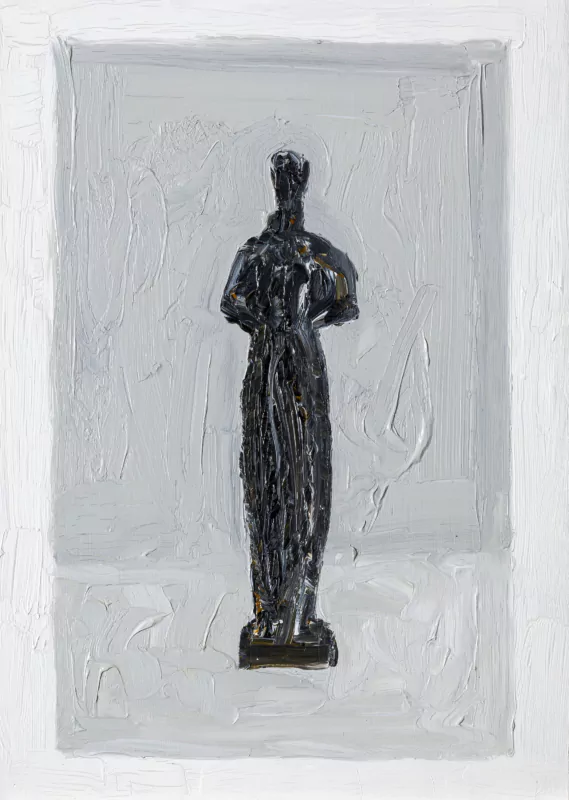
LE CATALOGUE DE BÂLE (detail), 2013-2015, after Antoine Bourdelle
CATALOGUE
The central second section of the exhibition presents a dizzying ensemble of a thousand paintings—Le Catalogue de Bâle (2003– 2013)—arranged within a great labyrinth, the visitor flanked left and right by rows of paintings hung so close together they almost touch. [6] Each work is executed using the same method, almost a ritual: Cognée selects an Art Basel catalogue, its pages containing superlative works considered the finest and most expensive on the art market, removes a page, and paints over in white everything—text, caption, catalogue entry—that prevents the reproduction of the work shown—be it a sculpture, painting, or installation—thus sparing it, and removing it from its context.[…] Painting after, then—after Hans Hartung, after Alberto Giacometti, after Jeff Koons, or after Pascale Marthine Tayou [7], but also, in the French language, painting on—peindre sur, in the literal sense of peindre sur le motif.
By this act, which is a translation of the mother tongue and therefore a betrayal, but a loyal betrayal, Cognée re-presents, through painting, a work that had been re-produced mechanically, on impersonal rotary presses. In other words, what barely fifteen minutes earlier had been an image becomes a work once more. It is a political act, then, to interfere with the workings of the world, to counter that over-saturation, not of paintings but of the images of paintings—in magazines, on cookie tins, in advertisements, on paperback covers— where each of those works is presented to us as if disembodied, without texture or weight, deprived of its corporeity and its grace, imbued solely with its own aura, an aura that is its fraternal twin and its false friend, hypnotic in its radiance, dazzling in its aura, its luminous metaphor exasperating itself in the world of smartphones and screens and immersive art experiences. This re- painting gives back to the work its primary, almost religious, vocation, which is inherent in its irresistible singularity.
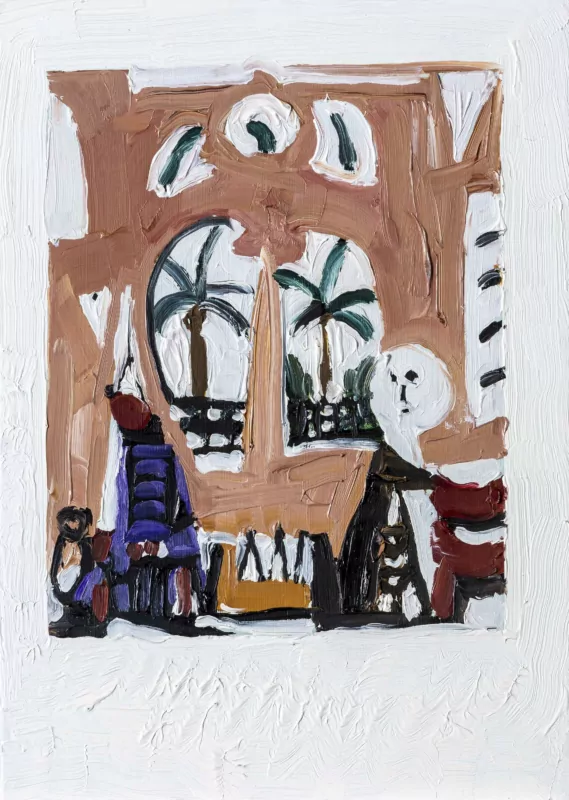
LE CATALOGUE DE BÂLE (detail), 2013-2015
In putting his hand to all these works – his treatment of the re-paintings indifferent to the nature of each original – Cognée creates a coherent, seemingly homogeneous history of art, all the more so in that all of the works thus conceived have the same format – that of the catalogue from which they came (21 × 29.7 cm). Better still, a history of art and a history of the art market, with their insights and oversights, their blind spots, inspirations, and aberrations. […]
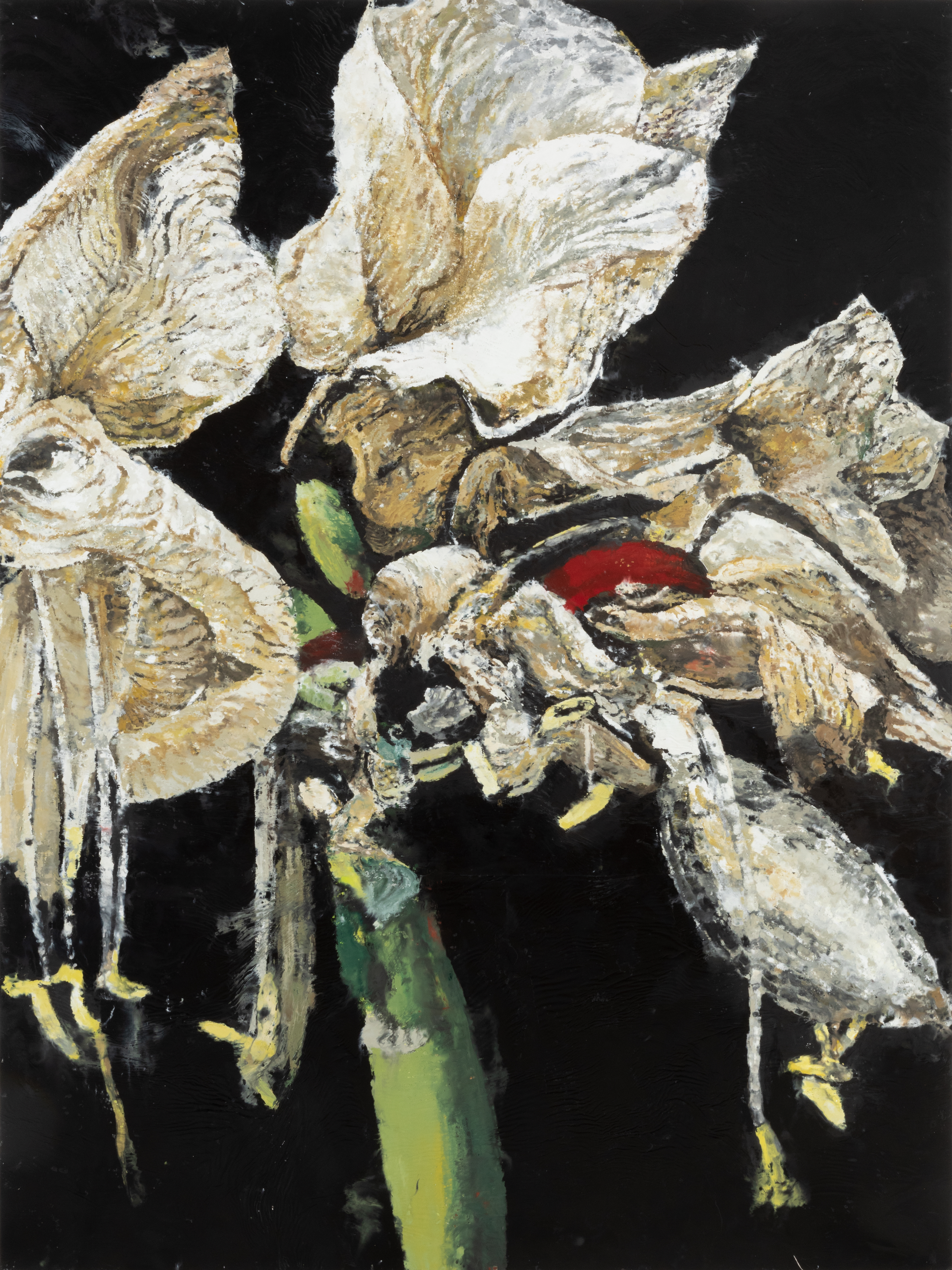
SAP
[…] Sap: that defining vital force that flows through the sculptures of Antoine Bourdelle, full-blown and impenetrable. The sculpture as flower—stem and petal, phallic and feminine, Apollonian and Dionysian. This is the allegory behind the new canvases produced by Cognée for the final section of the exhibition [8] pairing sculptures in the round and flowers, their vitality and their vigor. Pablo Picasso’s Flowery Watering Can (1951–1953) [ill.7], the philodendrons of Sam Szafran, who was a master of detail, and Johan Creten’s multi-colored flowers [ill.8], fragile, heavy ceramics, all go to prove it: with the same vitalistic principle, the same germination, sculpture and flower go hand in hand.
After all, did the sculpture not gain its independence by tearing itself from the monument, as a flower from its bouquet, a sunflower from its field, an asparagus from its bundle?
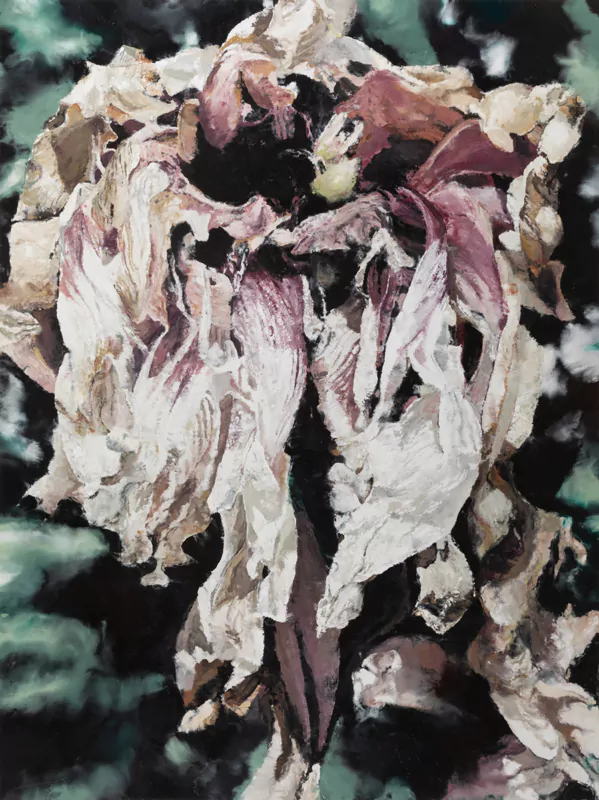
PIVOINE 2, 2022, wax painting on canvas, 240 × 180 cm, 94 ½ × 70 7/8 in
_
‘Philippe Cognée. La peinture d’après’, musée Bourdelle (Paris), until July 16, 2023.
Also ‘Philippe Cognée’, musée de l’Orangerie (Paris), until September 4, 2023.
Colin Lemoine is an art historian, art critic and writer. Responsible for the sculpture department at musée Bourdelle in Paris, he is a regular contributor to L’Œil and Le Journal des arts, and manages a literary collection at Flammarion. He has published two novels – Qui vive (2019) and Malgré (2023) with Gallimard.
This text is a reduced and edited version of Colin Lemoine’s essay, ‘Philippe Cognée, La peinture d’après’, from the catalogue of the eponymous exhibition published by Paris Musées in 2023.
- The term is mine.
- This brings to mind the University of Cambridge experiment that showed how a word can be read even when the letters are mixed up, as long as the first and last letter are in A gaze lightly skims and deeply probes.
- In his Corps du roi (Lagrasse, Éditions Verdier, 2002), Pierre Michon offers an intense reflection on the real and symbolic body, the “immortal” and the “functional” body, of the author, and the artist, who, reflexive by nature, does not shy from using images of self, both others’ photographs and reflections in the
- This expression of Arnaud Esquerre’s (Les os, les cendres et l’État, Paris, Fayard, 2011) opens the epilogue of Laurence Bertrand Dorléac’s definitive work Pour en finir avec la nature morte (Paris, Gallimard, coll. “Art et artistes”, 2020, p. 253). This brilliantly probing book was recently translated into an exhibition at the Musée du Louvre (Les Choses. Une histoire de la nature morte [Things: A History of Still Life], October 12, 2022–January 23, 2023).
- Pierre Bergounioux, Peindre aujourd’hui. Philippe Cognée, Paris, Éditions Galilée, 2012, p. 33.
- Small parts of this ensemble have been exhibited twice before, in different arrangements: in 2016, at the Fondation Fernet- Branca in the Haut-Rhin and in Saint-Gratien in the autumn of
- The expression to paint “after” combines these two notions, of continuation and inspiration, time and response, the time of the response—for every work is an echo. But of what? Cognée seems to
- The exhibition Carne dei fiori at the Galerie Templon in Paris from January 11 to March 7, 2020 was a resounding celebration of the artist’s exploration of the floral motif.
